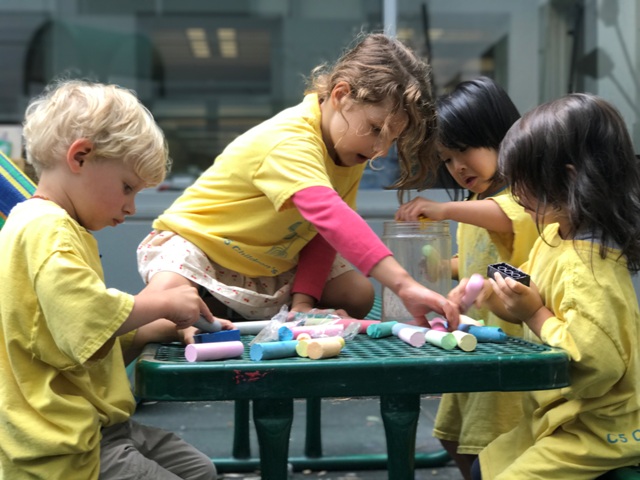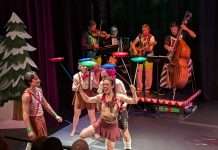Editor’s note: We’re happy to have Joe Wiseman, Director of Learning for C5 Children’s School, guest posting for us today.

You may be wondering about the best time to move your child into a program that helps prepare his or her rapidly developing body, mind, and social skills for the complex environment and demands of kindergarten and later life. The best time may be now if your child is beginning to demonstrate the social and self-management skills to follow directions and engage in group projects.
The answer depends on your unique situation and finding the right match, which you can determine by asking how the school accommodates unique temperaments, interests and learning styles so your child can learn in ways best suited to him or her. If you are ready to explore, the following may help you find the best preschool or pre-kindergarten program.
For a Young Preschool Experience
Ages 2-3.5
Look for a setting where your child can delve into fascinating explorations and expressions. This includes open-ended experiences with the materials, processes, and concepts of drawing, painting, sculpting, speaking, singing, dancing, symbol systems, lights and shadows, colors, and other activities that result in your child acquiring what the preprimary schools in Reggio Emilia, Italy, refer to as “The 100 Languages of Children.”
In a Mid-Preschool Setting
Ages 3-4
Ask if instructors can help your child engage their personal interests in in-depth explorations and group projects. The goal is to help grow their comfort level in working with diverse people, materials, processes, challenges, and possibilities.
In a Pre-Kindergarten Program
Ages 4-5
Look for a program where your child can continue becoming a powerful self-directed learner with high self-esteem, increased self-confidence, self-sufficiency, emotional intelligence, varied learning styles, and effective group process skills. At this age, energetic, creative learning group experiences are essential. So is an open-ended learning environment and a project approach that allows for individual differences. This results in more complex and compelling opportunities and challenges that lead to exceptional growth and development. It establishes a foundation of skills, attitudes, and knowledge that will serve your child throughout her or his life. Be sure to confirm that the program meets or exceeds typical standards for entering kindergarten outlined in the California Preschool Learning Foundations, Volumes 1 and 2.
Once you and your child feel ready for a preschool or pre-kindergarten program, look for these five key qualities:
(1) An Attentive, Knowledgeable Staff: Professionals who are comprehensively trained, gentle, caring, highly skilled, experienced, responsive, and collaborative. Ask about the expertise of the school staff. Does each teacher have Early Childhood Permit Levels of Teacher or above? Does the staff participate in continuing education courses and at least semi-annual professional development training? What kind of support do children get from staff beyond their everyday teacher; for example, from administration and specialists?
(2) A Guiding Approach: A program that gently and skillfully facilitates learning, as opposed to directing, managing, overpowering, entertaining, or tricking your child. Ask if the school offers significant opportunities for child-directed learning with teachers observing.
(3) An Ideal Curriculum: Through your research, settle only for an approach that is tailored to your child’s learning style, temperament, and other requirements. Then, make every effort to obtain this program. Be ready for possible extra distance, costs, and special efforts to secure and participate in the program. It will be the basis for your child’s optimal learning and development, self-image, worldview, quality of life, and success in working and in their community.
(4) Supports Your Child’s Personal Development: Rich, varied materials – from nature are best, such as plants, animals, woven baskets, wood, various papers, and clay – that support many different learning styles and levels; acceptance of various cultural influences; utilize individual interests as motivation and vehicles for learning; and, accommodate special conditions that exist or emerge in children. For instance, look for programs with school gardens.
(5) Parent and Family-Friendly Communications and Reporting: Comprehensive documentation that tracks your child’s learning journey and provides the basis for regular reports from and meetings with your child’s primary teacher. At minimum, make certain that the school provides a daily report of classroom activities and your child’s progress.
[hr]
Joe Wiseman, Director of Learning, C5 Children’s School
About C5 Children’s School
C5 Children’s School provides high-quality, comprehensive childcare and education for infants through pre-kindergarten students using a uniquely holistic and dynamic child-driven approach. With an emphasis on promoting integrated styles of learning and forms of intelligence ranging from linguistics and logic to musical and spatial awareness, C5 empowers children to love “learning for a lifetime” and become collaborative contributors to their community. Founded in 1985, the school has two locations in San Francisco’s Civic Center. For more information on C5, visit http://c5children.org.
To book a tour of C5 Children’s School, visit: https://tinyurl.com/c5schooltours.






















